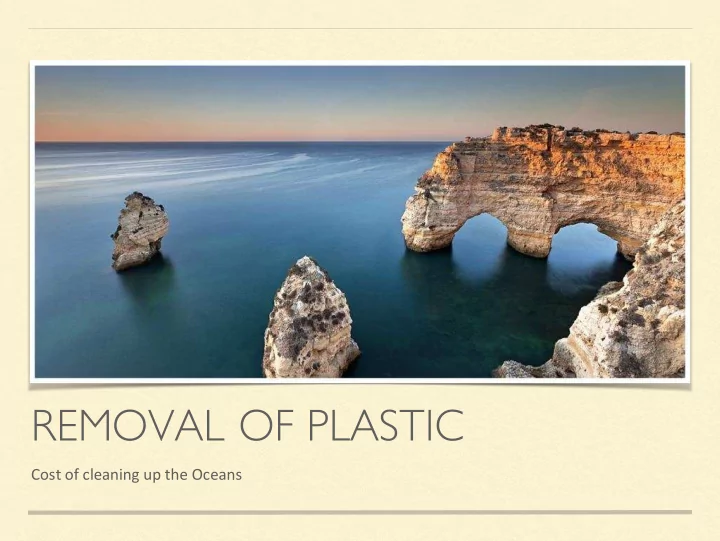

REMOVAL OF PLASTIC Cost of cleaning up the Oceans
THE CHALLENGE Purpose Estimating the cost of removing plastic to clean up the Oceans By gathering the following data Cost Quantity Size
DEFINING THE BOUNDARIES Be clear on the purpose of the model – e.g. is it to determine where UK should invest effort/finances for maximum impact? Ascertain the size of the problem – think about the context e.g. can you easily access plastic or do we need to separate it from other waste? Define the bounds and what your assumptions are – where in the lifecycle are you tackling? Plastic in ocean could be recycle/disposal phase.
AN EXAMPLE PROCESS 1. Determine the size/context of the problem* 2. Define reasonable boundaries and what is in/out – be realistic when setting bounds*. 3. Identify possible solutions – where possible ROM cost (used to reduce options) 4. Do a Needs and Numbers assessment 5. Cost out (a) proposed solution (greater depth – if possible) 6. Present your findings/conclusions * Could be in parallel/cyclical at outset to define problem
1. DETERMINE SIZE AND CONTEXT OF PROBLEM • There are 5 specific garbage patches • Total rubbish is some 150 million tons • Annual plastic deposit is some 8-10 million tons • Consider a 10 year clear up programme • Need to clear near 16 million tons/year Source: World Economic Forum Ocean Conservancy
2. DEFINE REASONABL BLE BOUNDAR ARIE IES – WLC? • Solutions to stop problem C • Assess solutions A • Development D • Use new material/solutions M • Embed in society I • Dispose / recycle / repurpose / re-use D
TAKING THE VIEW OF DISPOSAL/RE- USE/ RE-CYCLE STAGE AS OUR BOUNDS
3. IDENTIFY IFY POSSIBL BLE SOLUTIO IONS – EVALUAT ATE The Ocean Clean-up HQ Rotterdam 80 Staff Founded 2013 www.theoceancleanup.com Note – assumed we have assessed other options - exemplar
• System 01 already in use in the Pacific • Claims that 60 Systems could clear 50% of the great pacific garbage patch in 5 years • Teams based in Rotterdam and California
4. DO A NEEDS AND NUMBERS ASSESSMENT 1 2 3 4 5 6 7 8 9 10 Residual (million tons) 150 135 120 105 90 75 60 45 30 15 Annual Dump (million tons) 10 10 10 10 10 10 10 10 10 10 Actual annual (million tons) 160 145 130 115 100 85 70 55 40 25 Number of systems 500 500 500 500 500 500 500 500 500 500 Clearance per systems 0.05 0.05 0.05 0.05 0.05 0.05 0.05 0.05 0.05 0.05 Total annual clearance 25 25 25 25 25 25 25 25 25 25 New residual 135 120 105 90 75 60 45 30 15 0
5. COST OUT THE PROPOSED D SOLUTIO ION 1 2 3 4 5 6 7 8 9 10 Cost of system (£m) 5 Initial number of systems 500 Life of system 2 years Replacement systems 500 500 500 500 Procurement Costs £m) 2500 2500 2500 2500 2500 Total System Cost (£m) £12,500 Number of ships 5 5 5 5 5 5 5 5 5 5 Cost of ship (£20k/day) 0.02 0.02 0.02 0.02 0.02 0.02 0.02 0.02 0.02 0.02 Number of days 300 300 300 300 300 300 300 300 300 300 Annual ship costs (£m) 30.00 30.00 30.00 30.00 30.00 30.00 30.00 30.00 30.00 30.00 Total Shipping Cost (£M) £300 Staff cost Totals over 10 years • 80 current staff (technical + admin) • Systems Cost £12,500m • 100 new operators per garbage patch • Ship Costs £ 300m (5) • Staff Costs £ 120m • 20 new support staff Total budget ~ £13 • = 200 x £60k/yr (inc. O/Hds) billion • Total = £12m per year
6. PRESENT YOUR FINDIN INGS / CONCLUSIO IONS International waters – who will pay – this leads back to purpose of model and assumptions. High level of uncertainty across all numbers – low data readiness level Moving problem from ‘A’ – ‘B’ – what do we do with the material we collect? 10-year programme not feasible with this approach? Investment challenges Financial advisor – too much uncertainty and risk Banker – upfront costs are high Investor – low return on investment
TEAM PRESENTAT ATIO IONS Purpose of the model – where will it be used – level of detail required? Life-cycle – setting the scene and context – prevention as well as dealing with current problem (breadth of approaches) Understanding the problem – e.g. is the plastic mixed with other waste? Clear process/approach being used essential Comparing options to target problem Great effort from all teams
GREAT TEAM WORK BY ALL
Recommend
More recommend